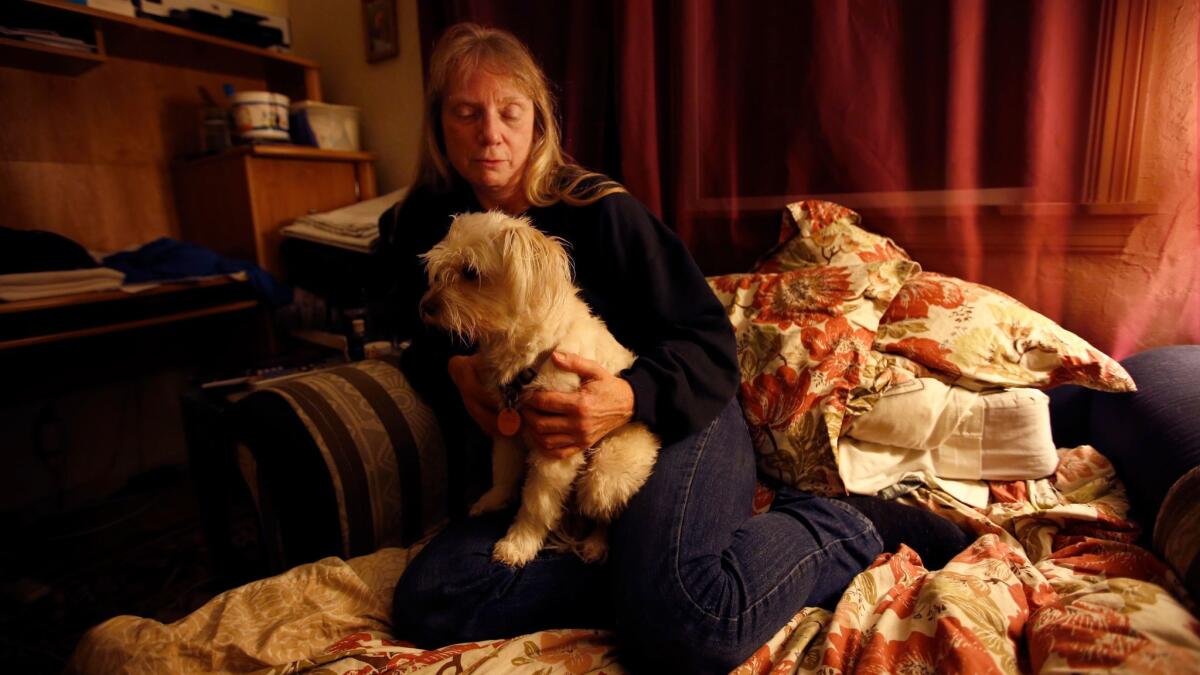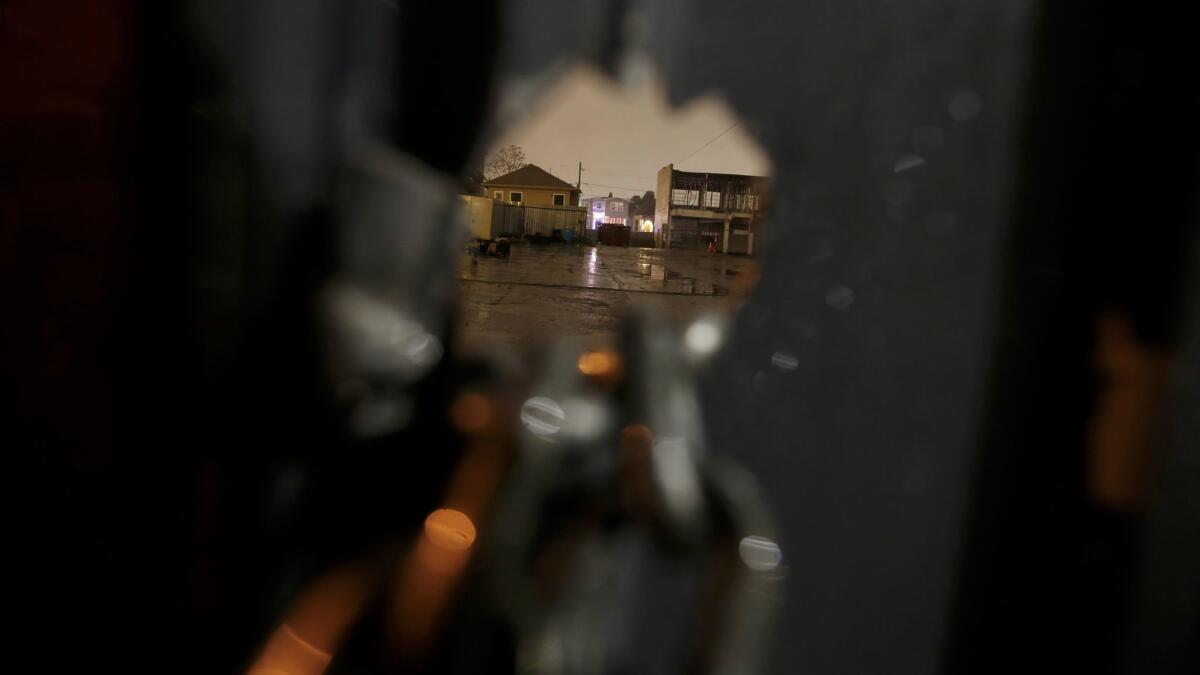Ghost Ship tragedy puts focus on plight of Oakland artists dealing with soaring Bay Area housing costs

The Ghost Ship fire tragedy puts a focus on the plight of Oakland artists dealing with soaring Bay Area housing costs. (Francine Orr / Los Angeles Times)
- Share via
Reporting from Oakland — The room for rent last summer inside the converted warehouse at 1919 Market St. in West Oakland had all the magic of an artists colony that Sam Code wanted.
Code, who sang and played guitar in bands, was drawn to the three floors of lofts connected by a network of ladders, hidden nooks and crannies, bright skylight and the paintings, mannequins and screen prints that revealed the imagination of everyone inside.
But something about the warehouse also left Code anxious: the long, dark hallways and just two exits for more than 100 residents.
“I knew right when I walked in that it wasn’t safe,” Code said. “But there was something romantic about it.”
In the end, his desire for a creative community lured him to move in — that and the cheap monthly rent of just $400.
It was a precarious decision, but one faced by uncounted people in need of cheap housing in one of the nation’s most expensive places.
Artists and young people like Code have long been drawn to Oakland’s flourishing cultural scene in a region known for technology and the riches it produces.
But soaring Bay Area housing costs are forcing some into dangerous living conditions. Tragedy struck one of those artist residences last week when 36 people died after a fire ripped through the illegally converted Ghost Ship warehouse in Fruitvale during a concert.
The horrific event could lead city officials to go after illegally converted warehouses across Oakland, especially as evidence mounts that building inspectors knew of numerous problems with the Ghost Ship property but didn’t take action.
Already, Oakland tenants housed in similar spaces are receiving eviction notices, and Mayor Libby Schaaf announced that the city is considering new fire and emergency exit regulations for its buildings. But any decision to condemn residences where artists are living illegally or force their owners to bring them up to code has led to worries that Oakland might hemorrhage more artists as housing costs continue to rise.
The state’s housing shortage has hit the Bay Area hard. Between 2010 and 2014, the region added about 446,000 private sector jobs but only 54,000 new homes. Oakland, where more than a fifth of all residents live in poverty and median household income is $25,000 less than neighboring San Francisco, is especially vulnerable to displacement and gentrification pressures caused by the region’s rising wealth and lack of housing.
Oakland has long been a Bay Area artists haven, even more so since the tech boom fueled a frenzied real estate market in San Francisco, where the median home value is now $1.1 million. The surging costs have pushed San Francisco artists across the bay to Oakland where they compete with existing residents as well as low-, middle- and even upper-income San Franciscans driven out of the city for limited housing.
Rents in Oakland grew by 68% between 2007 and 2015, a major report on housing affordability showed this year. The median one-bedroom apartment in Oakland now costs $2,200 a month, the fourth-highest of any market in the country. And more than half of city rental households are rent burdened, meaning they spend 30% or more of their income on housing costs, according to U.S. Census data.

Oakland’s artists are feeling the burden. In a city-sponsored survey last year, the majority of the 900 artists polled said workspace and housing costs presented the biggest challenges to being an artist in Oakland. Nearly half said they were on month-to-month leases in their houses and workspaces, putting them at risk of displacement, the survey found.
The story of 1919 Market St. could serve as its own cautionary tale about what could happen when city officials take action against illegally converted warehouses.
In January, after receiving reports of a leaky roof and tangled exposed wiring, Oakland city officials condemned 1919 Market. The warehouse had never received a permit for people to live there.
Code, 30, was evicted and lived at a friend’s house for 10 days. He moved to another artist community and ran into problems there before moving again last month to a home less than two miles from Ghost Ship. Code and his partner now share $1,525 a month in rent, nearly doubling what he paid at 1919 Market. Code and other former residents are suing their former landlords, who have denied wrongdoing in court filings.
“The solution, I do not think, is to shut down these spaces,” Code said of 1919 Market and other illegally converted warehouses. “I had resources I could fall back on. That’s not the case for everyone.”
Others have had more difficulty. Joy Newhart, a 60-year-old dancer and choreographer also evicted from 1919 Market, paid $600 a month to live and work there. Since the building’s closure, she has been unable to find stable living.
Last spring, she moved in with friends, one of whom assaulted her and harmed her animals, she said. Then she moved into motels. Over the summer, she went to the East Coast, traveling between Philadelphia, Atlantic City, N.J., and Washington D.C. Ultimately, she moved back to the Bay Area and is now staying with other friends.
After her eviction, Newhart had to move her computer equipment into storage, which forced her to lose her small income from producing videos of corporate events. She now lives solely on the $1,200 a month she receives in federal disability payments and is considering moving to Crescent City near the Oregon border for more affordable housing.
Newhart blamed the city’s building department for being callous to the fate of residents evicted from 1919 Market.
“Yes, there were fire problems. Yes, there were electrical problems. Yes, there were problems with all of those things,” Newhart said. “But they could have worked with us to keep us within our homes. They didn’t need to throw us out on our asses and make us all homeless and destroy our lives in so many ways.”
Now, a developer is turning 1919 Market into a 63-unit apartment complex designed for young professionals who will pay higher, market-rate rents. The building is located less than a mile from Uber’s planned, new Oakland corporate headquarters.
City officials say they understand the worries within the artistic community about their response to the Ghost Ship fire.
“I’m very much concerned that we not become knee-jerk and overreact in a way that leads to massive displacement,” said Oakland City Council President Lynette Gibson McElhaney. “It’s really important that we do not add more injury to this incident and this community so that people don’t feel terrorized and then get kicked out onto the street.”
Gibson McElhaney said she was examining models from around the country, including New York City, that aim to encourage artist residences to comply with building codes. She added that the City Council planned to look at increasing penalties on landlords operating unpermitted spaces and whether to devote more resources to the building department and code enforcement.
Last year, Schaaf created a new housing inspection program to encourage tenants to report unsafe situations without fear of a landlord’s increasing their rent to repair hazardous conditions.
This week, Schaaf announced that the city had received $1.7 million in philanthropic donations to support artist housing and is reconvening an artist housing task force. Schaff said she recognized the pressures artists were facing.
“The arts are at the center of vibrant and diverse communities, and are critical to neighborhood health and well-being, yet artists and cultural organizations are increasingly vulnerable to instability and displacement,” Schaaf said in a statement.
Still, advocates say balancing safe living spaces with affordability is a problem no one in the city has figured out how to solve.
“I don’t know that there’s anybody who has come up with a silver bullet yet,” said Robert Gammon, a senior editor at Oakland magazine who has written about housing concerns in the wake of the fire. “If they had, we wouldn’t be having this discussion.”

Follow me at @dillonliam on Twitter
ALSO
Victims of the Oakland warehouse fire: Who they were
‘It’s excruciating’: Inside the heartbreaking recovery of 36 bodies in Oakland warehouse
L.A. plans crackdown on unsafe warehouses in wake of Oakland tragedy
More to Read
Sign up for Essential California
The most important California stories and recommendations in your inbox every morning.
You may occasionally receive promotional content from the Los Angeles Times.











